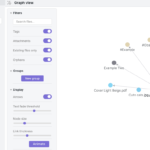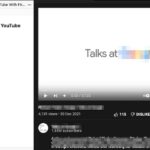I am wondering what are the modern ways a learner may use mind mapping for memory purposes with note-taking apps. Of the traditional methods previously evaluated, Mind Palace of mind mapping stands out to be more interesting for more discussion. I hope we can revolutionize mind mapping to another level with modern apps or creativity. The advantage of mind maps is in their visual impact. It is definitely better to be able to remember well than not.

What are some mind map note-taking methods and tools:
Methods
- Manga as your mind palace base – Ready-made and interesting story for you to start your notes association. Highly Recommended.
- Zoo, bird park, botanical garden flower show, an aquarium for mind palace. Highly Recommended.
- Board games for mind palace. Recommended.
- Reverse engineer your Mind palace method – Stories for associative notes learning with Google My Maps. Recommended.
Web, desktop, and smartphone tools:
- Create a custom Google Map for notes-taking – Tell a story (optional).
- Prezi – Note-taking in a presentation style with basic animation
- Mind map package with Atom – Create Mind maps with a coding editor Atom
- Evernote & Notebloc – Scan hand-drawn mind maps
More tools:
- Coggle – A mind map web app
- Canva Mind Maps – Basic mind maps with a web graphic design app
- Mindly – Create mind maps on an Android phone
Traditional mind mapping may have only written words or notes strewn by lines. However with modern technology, mind mapping maybe even more effective and ‘cleaner’ than before with straight or curvy lines, boxed images, clear and neat text structure, and even some animation or based on world locations. However, the main focus here will zoom into Mind Palace. I prefer free solutions or hopefully at least feasible to start without too many restrictions and payment.
Methods
Manga as your mind palace base
Many teens nowadays are open to new and creative reading works such as Japanese manga. Certain manga can be a good story source for Mind Palace for a few reasons.
- First, it is a ready-made visual story complete with the environment, characters, and plot. It can save you a lot of time and effort reading a new story for an associative purpose.
- Secondly, manga can be entertaining, engaging, and artfully beautiful, spicing up monotonous learning. Re-reading the manga can be a joyful experience as compared to forcing ourselves to review boring notes repeatedly. Whenever you read the manga again, the notes you made or added can appear to serve as a review. When you associate your notes with an enjoyable activity, you may experience a better mood when studying or reviewing.
- Thirdly, a manga book is usually not thick and provides a quick read for the busy. A short manga book story ending will force the reader to stop, and the Mind Palace user can start reflecting and brainstorming how to go about associating the notes with stories. Manga books are also easy to bring around for quick reviews.
View and use your manga book as a personal notebook with a ready-made story template.
Exercise:
- Buy a good, interesting manga book that can be appropriate as a good base for your Mind Palace. Read that book (A manga series can be reserved for a particular subject).
- Brainstorm, arrange, and associate your notes with your manga. You may use Post-it notes or write directly with a pencil on the book.
- Perhaps one note for each page or scene that makes sense.
- Dialogues are very common in manga, so it is easy to change or add the content of your notes to them to make an association. The more meaningful is the association the better.
- Read the manga again, you may have better ideas and inspirations to re-arrange and associate your notes. You should be able to narrate or tell the story easily and the associated notes should be visualized effectively.
Tip: Most manga books are not colored. You may color them briefly at important milestones and where they are relevant to your notes to make them stand out. You may use Stickies of different colors and colored pencils to write instead. However, know that your understanding and logical analysis are paramount in any study so feel free to use colors if you are not distracted.
Alternatively, you may paste Stickies notes on comic books, even non-Japanese children’s book such as Asterix and Tintin are rich in visual and story appeal. Alternatively, one may even start with engaging children’s books, for example, by classic authors such as Enid Blyton. (affiliate links included).




Tip: Watch and take notes on a movie or show
Movies and shows are entertaining, but they can also be educational and inspiring depending on the content. In fact, they are, in all likelihood, a more effortless way of learning knowledge forging a more enduring impression because all one has to do is to sit through watching the screen (and reading subtitles) whilst listening to the audio system. You may even use Playstation Games’ characters, objects, and environment for associations.
Zoo, bird park, botanical garden flower show, an aquarium for mind palace
Apply the same concepts of mind palace to any place that you might be interested in. It can also be a library if that is your preferred place. The place should have plenty of classifications and details for association purposes. Just creatively associate different notes with selected objects or animals in a logical order so you can mentally re-visit and easily move from one association to the next seamlessly. The more logical is the association the better quality. Expert mind palace users may recall these ‘journeys’ almost instantly. Making interactive, good-willed, and sincere connections to other life forms without expectation of return can be one of our best choices in life. Remember to fill your smartphone with camera photos and videos of these memorable moments even if you do not form immediate associative notes. The photos and videos taken can also be uploaded into a personalized google map (covered later) for review or sharing. Sharing your joy and love for flora and fauna with others may have a more fulfilling and deeper meaning to life than just personal pursuit of knowledge. All life is priceless.
Tip: You may even sit at a busy place, and observe to remember the interesting people who walked by to make associations. People-watching can be quite an educational and valuable lesson in addition to helping you make easy associations with various details. The more you study people, the more probable you may differentiate various types to help choose avoid or right people for association in later life.
Board games for mind palace
There are numerous board games out there on the current market for you to choose from to engage in mind palace exercises that were not available in the past. Times are evolving and we find ourselves perhaps with more resources shelved away than we appreciate or recognize. Good board games require good ideas, planning, manufacturing, and marketing before we can buy them, and every board games and even card games are usually full of visual elements that can be excellent resources for mind palace. You may even acquire a few different interesting board games, each for different subjects or important topics in your life.
I would recommend board games (or card games) that have a built-in story element (though not necessarily because we can work on that mentally), are non-violent, do not plot against others, and have a dark or scary aspect to it lest you have nightmares. There should be interesting visual elements to help you remember vividly the associated details. Mind Palace with board games is straightforward as you associate your notes with the settings, events, and components of the game. Board games can be very interactive when more players are involved but the board game itself can also be creatively used in a way as an effective ready-made template or resource for your important class or work notes. Instead of a manga book or personalized Google Maps, you have a board game for a memory power boost.
For board games suggestions, please refer to Resources.
Exercise:
- Pick any good, suitable board game.
- Create good mental associations between each board game environment, story events, characters, and other components with your notes in a logical sequence e.g. storyline, chronological, numbered location, or circular direction.
- Review the story and components with your notes all over again.
- Bring a board game piece, card, or character figure with you when you travel to remind you of that particular note’s significance. Refer to your main notes to check if you got it right. And review a couple of other related points while you are at it.
With the right board game, you can even be learning two subjects with one board game such as chronology to learn history timeline with geography/literature notes or just for those wondering how to take notes for history. You do not have to buy a new one if you have a suitable board game at home that you can use right away. You can also arrange your notes neatly together with your board game pieces and take clear photos to help you review each photo as a notecard with a description of the association.
Tip: Use a diorama. For example, miniature sets shot for movies. Or Japanese miniature landscape therapy. When we construct these mini models of people, architectures, and objects, we are making a conscious effort to create or represent them. We would naturally think of the possible best ways to present our intentions. And we could even animate the entities or use lines to represent motion trajectories like in a crime scene for a more accurate representation or spur our imagination in directions that hadn’t crossed our minds before. And this is where we take notes of alternate perspectives.
The next time we see kids play with models, dollhouses, and painting or drawing, this could be their playground for their creative imagination. Encourage them to create models and beautiful works of art. Even sands can be used to speed draw a beautiful painting, and photos were taken for note-taking. This can be a lifelong, appreciated skill of high value and enjoyable experience if one perseveres. Check out Resources for links to sets & dollhouses, and more.
Reverse engineer your Mind palace method:
Begin with a short story or a chapter plot of your favorite book instead. Then associate your notes and the Google My Map places (covered later) as you move along with the story. Replace the story location settings with the Google map places, and perhaps story characters with people you know such as your class and workmates. Integrate some of the dialogues with the notes, you want to memorize. As you get more familiar with this technique, spin-off with various story plots and add on more intriguing & emotional elements such as videos of songs and poetry. Google my maps support text notes, URLs, images, and video attachments. For voice notes and lengthy articles, put it on Evernote and copy the public link for the map pin’s URL insertion. This method may be the easiest and more suitable way to practice the mind palace technique for modern lifestyles.
Exercise:
- Learn a short story e.g. A Street Cat Named Bob (affiliate link) or any you prefer. Even your most recent drama or movie story you watched.
- Prepare your list of notes to memorize
- Take many photos and videos of your chosen route. For example, take photos at every single bus or train stop. Note people, objects, and animals of interest like a white cat with different eye colors, etc. Also, note down any inspirational moments you experienced such as when and what song you listened to feel which positive emotions.
- Create a new Google my maps. Insert all the photos, videos, and experiences into the map.
- Consider the best way your story may fit in with the places.
- Associate and apply your notes as logically as you can to the story and places. The story may be simple but impressionably personal and emotional.
- Review this story or mind palace until you are familiar.
The disadvantage of this method is that you should have a story ready before you start but these days we are exposed to so many books, television shows and movies this should hardly be a concern. The advantage of this method is that even a diary of a day can also be used as a story with Google my map.
It is also possible to just drop the story-telling element altogether and start creating pins with private notes information on Google My Maps for Mind Palace. To find out more about the technicals of how to create a Google map for your personalized note-taking please read on.
Tools
Create a custom Google Map for note-taking
This ‘Journey method’ way of Mind Palace learning with world maps can be more effective if you had been and remember the places well. For example, perhaps you can base the learning on a jogging route, bus and train route stops, and even your usual shopping places. Take pictures of these places and items to help you jog your memory and make associations. Examples One and Two are illustrative technically how to create these notes, however, the examples did not integrate a story element.
Example One:
Here is a quick and basic example (open new tab) of how to use a custom google map (preferably of places you are familiar with) to take notes and make associations.

- Click on the search box to start creating a custom map based on a location. (click to rename the map)
- Click on different landmarks, edit and add a note. (click the marker and line icon to add your pins and line)
- Change the style to a number of sequences on the right
- Click to enable share and embed the map on your sites.
For each of the five locations, I have added associative notes that illustrate the benefit of the visual map linked with related notes. You may wish to capture screenshots containing each and every pin note for a quick and easy overview.
Once you have created and added all the notes to Google my maps, click and save the preview tab link (example). This will load up the public images along with your own notes in a tidy fashion that may be excellent for reviewing purposes.


Example Two:
This is another example of a custom google map (full instructions) with the use of CSV files.
Briefly:
- Log in and go to Google My Maps, click create new Map, change the name to i.e. Shark spots sights, and fill up the description.
- Download Sharksightings.csv and sharkspotter-beaches.csv or create your own CSV and upload.
- Click import and select one CSV file. Repeat for the other.
- Click the Marker icon (which looks like a balloon) and put it on the map to create your own point of interest. Click on any points and edit to change its fields i.e. to add a note and attach a photo.
- Click style (uniform for all or individual style of a separate single entity). There are different colors and many icons for you to choose from. Or choose a Sequence of numbers and set the label to Dates for those who prefer a chronological or numbered path to learning.
- Click share to allow the public to view or collaborate with others to improve the map. Click the 3 dots beside the map title, and embed it on site, copy and paste the code to integrate the map into a site.
- Base map (optional) for selecting different map types.
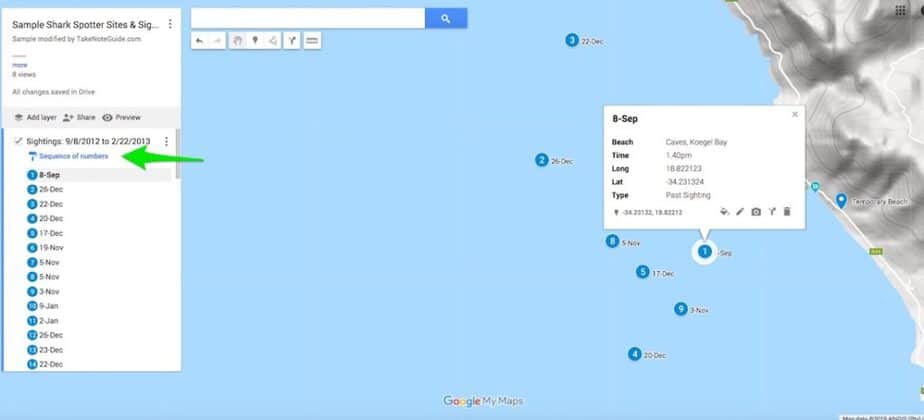
For those who prefer, select a sequence of numbers instead of uniform styles. Optionally set the label to Dates.
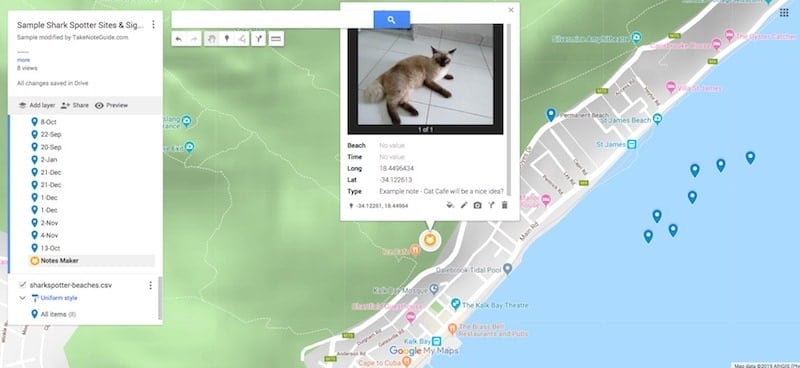
Add a note marker to anywhere on the map, and attach an image in addition to the note for enhancing memory retention
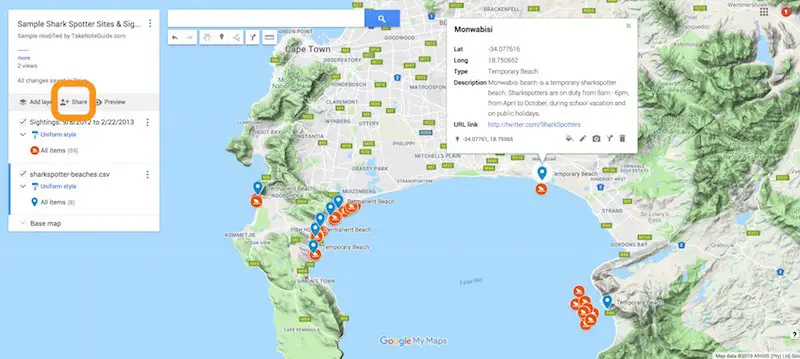
Other possible modern scenarios are supermarkets and malls to help you associate and remember notes. Google trips can recommend some places of interest nearby or somewhere else under Day Plans or Things To Do, but Google Maps on Android and iPhone have been updated with ‘suggestions’ and augmented reality.
Tip: Record your screen e.g QuickTime Mac App for free, while you click from first to other pins or landmarks to view the notes. Reviewing the video a few times can pace learning.
Bonus tip:
Story-telling can be a powerful way to learn. As you move through the numbered points, can you come up with a story to tell? It would be much more interesting and impressionable when you have a sensible story that connects the different points of interest and notes. If your time is limited, then you may choose only important or lengthy topics notes for story construction. For example, the places of interest may also be a previous class trip or a family outing to a memorable place. You may associate class notes to the photos you had taken and told a different story of how you would plan your next trip with your beloved pet or family to these places again. And another story for another topic or chapter notes and so on.
For example, imagine you brought your parents to the museum of contemporary art, upon arriving at the first piece next to the left entrance, your Mum gasped at how feathery and light the water-color piece ‘River Rocks and Smoke by John Cage’ was. And you wonder if the painting also used the powders of Strontium SR 38 and Boron B 5 (chemistry notes). And such as your family journey through the museum. Add in some twists and suspense to make the trip more exciting and you have a more compelling story that you can practice visiting again to improve the story while enhancing your memory of that journey.
In short, make your notes all the more special with intimate moments at familiar and interesting places such as Google Maps places and your favorite rooms with a strong logical storyline, and practice to improve your technique just like writing.
Working with a physical world map can be a good alternative to those who prefer using stickies notes and pins. A Scratch Off World Map Poster (affiliate link) offers a more interactive approach as well.
Prezi – Note-taking in a presentation style with basic animation
Prezi provides a clean look for presentations and simple animations. Prezi is simple and intuitive and can be used as a notes app for important information, and a screen recorder can let you review with animation the different notes at a steady pace.
I have created a simple Prezi presentation to illustrate the potential of note-taking with Prezi. Prezi also sharing with anyone with a link. Prezi also allows embedding as follows, please feel free to click around or zoom in and out.
Alternatively, adapted from the Roman Room Method (one of Mind Palace techniques) , you can take lots of photos of your favorite room’s objects and people, arrange them in Prezi (and zoom in to some objects attached with associative notes) as you make a presentation trip around the room, preferably with a story to tell or dialogues from different parties. The advantage of using Prezi is the ease in playing (practicing) repeatedly the images with notes in a structured flow order just by hitting the next button.
Mind map package with Atom
The advantage of using a mind map with Atom is having more free control with open-source software. This approach is more for those who are comfortable with coding editors. Please read how to use Atom to take notes. If a flow diagram i.e. UML diagram is more suitable for your need, Typora can be a good solution, go here for more information.
Evernote & Notebloc – Scan hand-drawn mind maps
Evernote (refer here) and notebloc (here) can scan your hand-drawn mind map with ease. Those who prefer to take notes by hand and draw pictures are welcome to construct a story with a mind map or mind palace.
More Tools
Coggle
Coggle is simple to use, just hover around the node boundary and click the plus sign to extend a node or right-click for more options. In addition, it also has presentation mode, sharing options including embedding and download formats such as PDF & PNG. Coggle automatically use a new color for each added branch and kept them neatly arranged and spaced out. Like some others, coggle only offers 3 private diagrams, but lets you create unlimited public diagrams and more.

A simple coggle example with instructions. The public link goes here.
This is an example of a Coggle embed.
Canva
Canva Mind Maps has some basic templates for free use with sharing & download options.

Mindly – Android
If you create mind maps on an android device, Mindly is a possible solution as mentioned with the screenshot in this post.
Should I use mind maps?
Whether you wish to employ mind mapping and/or mind palace as a note-taking technique is really up to your choice of preference, especially if you had a good experience with it. Stay focused on creating quality notes content instead without being distracted by its various forms.
When to use mind maps?
- The individual is inclined to process visual data
- The subject matter is suitable for mind maps, those that involve associative notes type e.g. items and vocabulary compared with some other topics such as mathematics calculations or coding.
- Motivation to use mind maps can be a probable factor
- Depends on the creativity and imagination of the individual. For example, mind palace with the use of a train trip and Google maps locations or coming up with a good story plot of a locked room mystery with associative objects and notes.
Conclusion
As mentioned in my other post here along with some mind map studies summaries, I recommend using Mind Palace for those who prefer mind maps. Interestingly, a mind map efficacy study (Farrand, Hussain, and Hennessy, 2002) concludes it is effective but motivation has to be considered. The mind map method may require more effort by the individual, to begin with, and perhaps that is why not all are keen to continue with it. This is one strong reason why I highly recommend Manga as a Mind Palace base method. Not only do you have the places mapped out for your mental journey, but replete with characters and a story plot to help your story flow. So all you have to do is associate your note prepared beforehand with the manga book and enjoy reading your manga again to review your notes.
My top recommendations are the use of Manga and certain places for Mind Palace activities. The downside to using Manga is the risk of distraction since it is entertaining and engaging. The learner has to discipline himself to stay focused on the note-taking task.
I would also recommend board games and Google My Maps for a Mind Palace similar approach to mind mapping. There may be more benefits to this approach than just use-and-discard mind map notes. When basing our notes on places we know or are interested in, we may make these associative connections repeatedly or with more enthusiasm.
Further, these pins or places may have more details readily on hand to construct more associations for memory or coming up with a story. Imagine if you have a story to tell yourself and others, remembering the details and notes will be easier and more natural. When you bring the power of imaginative storytelling into your notes together with maps and photos, you make strong associative links to your notes.
These may bring about more powerful memory retention and even more brainstorming ideas to make creative opportunities. Perhaps another unexpected benefit to those who are trained in mind palace is the prospect of writing a book with more ease because of the numerous linked-list ideas and information that can be triggered with just a simple visit to the map or mental walk-through.
There are different tools e.g. Manga, board games, Google My Maps, and Prezi, available to assist in constructing your mind palace or mind maps, however, it is up to how we use and practice our notes with these tools that may determine the effectiveness. In other words, the methods and its repeated applications are of higher significance in my opinion. Also, which method is better also depends on the individual himself.
I believe mind palace or mind mapping, like any other skill, becomes more useful and powerful with practice. Good luck and be kind.

Related Questions
Where can I learn more about the Mind Palace Technique?
It is traced to the Method of Loci on Wikipedia, a mnemonic method mentioned by olden times Romans and Greeks for better memory performance via visualization of familiar knowledge of location or place. There is also the mention of mapping visually of the house. Other names include ‘Journey method’ (with an example) for lists of related things – I believe my recommendation of Google Maps uses this. The article also proposes creating stop points and associating them with images, just like in Google Maps visual pins. And practice. Interestingly, this technique can also be used to learn the vocabulary of a second language (Doner, 2014 Ted Talk). Another approach is the Roman Room Technique for memorizing unrelated information with examples of associating an unrelated list with different objects in the room first. Expansion to other rooms (perhaps categories) or a familiar town view (Think Google maps for modern notes) are possible. A World Memory Champion used his own house in 30 minutes to memorize 1040 digits. Resources have links to dollhouses and playsets that can help visualize notes associations and study books. Pictures can be taken of each object and annotated in a note app or a short story written on the note and object. Modern miniature rooms of beautiful structures with detailed objects are convenient resources for the Roman Room technique in my opinion.

Also, a room design planner by Living Spaces can help you map out your associations with a virtual room. However, working with a physical existing room you are familiar with could be easier.
What about paid mind mapping solutions?
There are a number of paid mind mapping apps on the market, but these are not the focus of this post. There are ample free apps to choose from in my opinion, and the main importance is taking quality notes.
Are there other maps alternatives to Google Maps?
There are some available here, however, they may not allow you to use them for personalized note-taking purposes as Google My Maps does.
Are there any books that teach how to apply mind palace with examples?
Dominic O’Brien, a multiple memory champion winner, authored at least 2 books that may help you with exams and general memory. Please refer to Resources.
How do I apply mind palace for remembering titles?
The Memory Palace book described in Resources may help you to memorize titles and more.
Bear in mind that Mind Palace’s limitation can be the memory purpose boundary, less for understanding and logic of subject matters which I hold in the highest regard (Please read One Sensible Way To Take Notes Effectively!). Also, not so much for topics that require lots of practice and certain realization like Maths and programming that you need to keep doing the exercises or testing with troubleshooting to understand more instead of just visual mapping to memorize. Remember it is logical understanding that matters most in examinations and daily life. Like all other recommended resources, please read the reviews and research to decide if this book is a good buy and fit for you or not.
Mind palace with music and songs?
It is possible to experiment by listening for suitable inspiring music pieces and songs with lyrics of places for mind palace mapping with your notes.
An alternative exercise for the musically inclined:
- Find a familiar place where songs and music scores are kept. This can be your personal CD rack/shelf or choose your favorite music shop that you frequent.
- Starting from the first CD, for each song or score, associate each or more related notes to a song part or score. For example when the chorus play, associate that emotion and particular piece to your more important notes with whatever positive imagery that comes to mind.
- Observe where is that song/score kept and play that song again to repeat the connection with your notes till you are satisfied with your memorization.
- Practice in your mind what you hear, feel, and remember when you retrieve that CD (and play the tune mentally) from that location you know well.
Are there resources that train logical thinking?
Dr. Eureka Speed Logic Game & 10 critical thinking card games book, both mentioned in Resources (including card games for learning languages).



